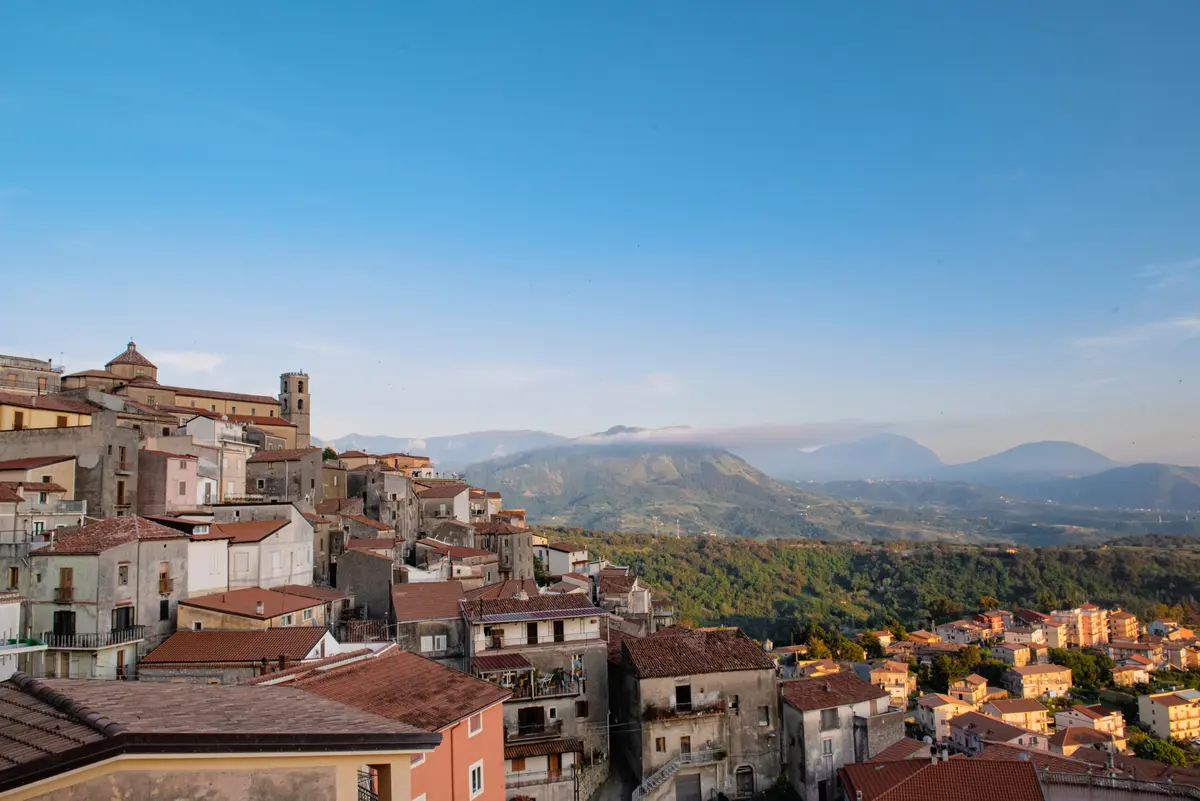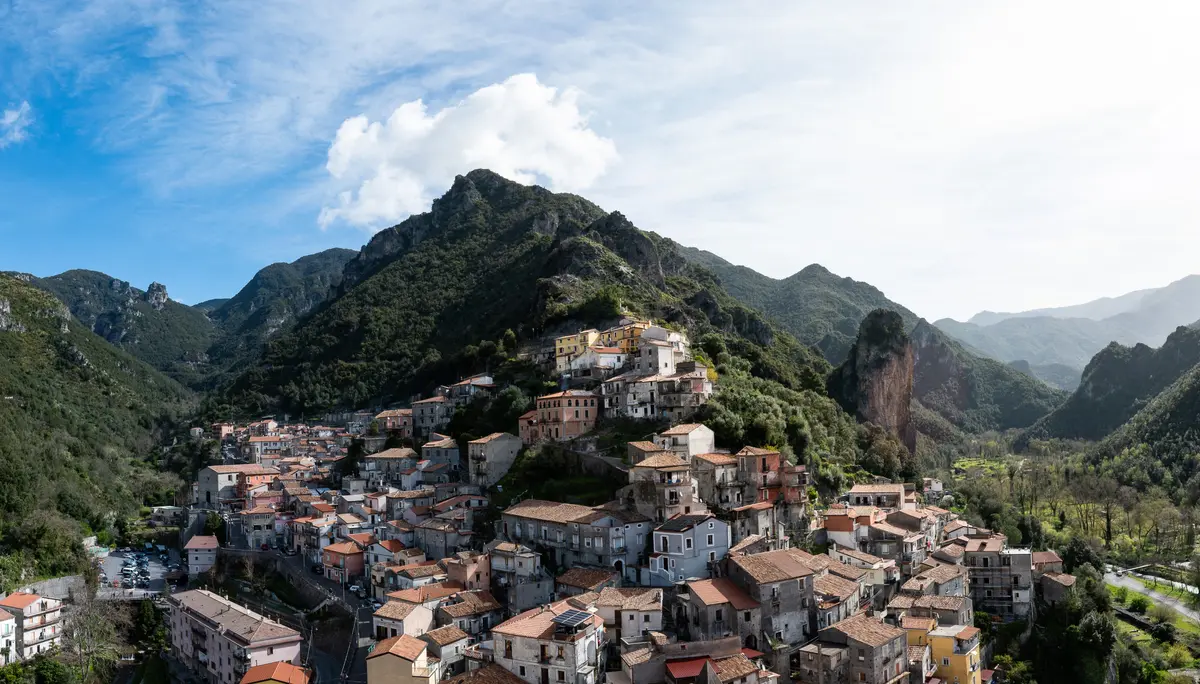Tortora
Tortoira, the old town of Blanda between past and present

Blue flags
Tortora is located in the enchanting Riviera dei Cedri (Citrus Coast), in the Tirreno Cosentino.
This is one of the most ancient Calabrian towns, with human presence dating back to the Palaeolithic, as evidenced by the remains found in the area during various excavation campaigns.
The area of Tortora has preserved important traces of the various civilisations and cultures that followed one another since the Palaeolithic.
A large part of the area of Tortora is included within Pollino National Park. At the end of the century, on the hill of Palecastro, the Roman colony of Blanda Julia was founded in honour of Gaius Julius Caesar; its town centre would subsequently give life to Tortora. In fact, from the IX century, Blanda was permanently abandoned due to the continuous Saracen raids and some of its inhabitants took refuge inland, where they founded the small village of Julitta placed on a rocky spur, which later took on the name of Tortora. The etymology of the name "Dove" is evidently linked to the Latin term "turtur", referring to the bird that found within this area a natural habitat in which to live and reproduce. The wild turtle-dove is also portrayed in the municipal coat of arms.
Old town
Tortora’s historic town centre has much to offer to its visitors: Piazza Pio XII leads to the town's main street, Via Garibaldi, where the Palazzo Feudale is found together with a medieval tower.
Piazza Dante boasts many churches of the municipal area and among these, the town's oldest church: the Chiesa delle Anime del Purgatorio (Church of the Souls of Purgatory). In the highest part of the village the Franciscan Convent can be found in the highest part of the village, where visitors can enjoy breathtaking views overlooking the valley below. It is a monumental complex, built in the XVI century, which also includes the church dedicated to the S.S. Annunziata (Holy Annunciation) and a cloister. Entrance to the church is through a rectangular portal surmounted by a triangular sail with a painting inside depicting the Annunciation. The church's interior has a single nave with a wooden ceiling and preserves a wooden statue of Saint Anthony of Padua, whose worship in Tortora is very deeply felt, as well as several paintings depicting scenes from the Bible. To the right side of the entrance portal, on the main façade, there is an arched portal which gave access to the old square-shaped cloister that has maintained its original structure. The Chiesa Madre or main church, built during the XIV century and enlarged around the XVIII century, is located in the lowest area of the historic town centre. The front entrance, in neoclassical style, has three rectangular portals. The upper part of the façade features two niches at the sides containing the statues of St Peter and St Paul and at the centre, a rose window with the head and shoulders of the Sacred Heart. On the left side of the façade stands, slightly higher, the spired bell tower with a clock and church bells. The interior holds sacred items in silver, various wooden statues, including that of its patron, Saint Biagio, frescoes and paintings of exquisite workmanship; among these is a canvas attributed to the school of Mattia Preti.
Other religious buildings worthy of a visit are the Chiesa dell’Annunziata (Church of the Annunciation), in piazza Monastero and the Cappella di Materdomini (Chapel of Materdomini) in Via Materdomini.
All streets of the historic town boast a great number of stone portals that adorn the buildings.
Tortora Marina
The beach of Tortora Marina is located on the coastal strip known as the Riviera dei Cedri (Citrus Coast), that overlooks the Gulf of Policastro between two seaside resorts that are quite popular internationally such as Maratea and Praia a Mare. The seashore, long and narrow, is made up of coarse sand mixed with gravel and pebbles. The sea is crystal clear and has a specific colour that ranges from turquoise to cobalt blue. Tortora Marina is visited by both families with children and toddlers, so much so that it was awarded the prestigious Green Flag awarded to the best Italian beaches in terms of hygiene, cleanliness and safety for children. The tourist boom of the eighties resulted in the emergence of a large number of accommodation options and modern residential complexes. Along the main road that leads to the town, remains from the Roman period of Blanda Julia's Mausoleum can be seen and on the banks of the river Toce, we find the Torre Nava; a watch tower dating back to the Saracen period.
Archaeological Museum of Blanda
The area of Tortora, which borders with Basilicata and Calabria, has preserved important traces of the various civilisations and cultures that followed one another here since the Palaeolithic, such as the Oenotrians, Greeks, Carthaginians, the Lucanians, the Romans and the Longobards. The Archaeological Museum of Blanda is a journey of discovery through the various historical periods that witnessed the development of Blanda and its ancient medieval village. The museum shows archaeological finds in 3D by using virtual models, due to an innovative combination between archaeology and multimedia, which contributes to making the experience much more enjoyable. The finds on display cover a timeframe that goes from the Bronze Age to the late Roman imperial age and come from a series of excavations that ended with the establishment of the Archaeological Park of Blanda. The Archaeological Museum of Blanda is located in the Palazzo Casapesenna, in the historic town centre of Tortora.
Gastronomy
Even today, Tortora's cuisine reflects the traditions of its past, defined by habits and popular beliefs. The local gastronomy has made the influences of Oenotrian cultures its own and offers simple and tasty dishes. Star dishes in Tortora are the Zafarana; sweet red peppers, with the characteristic shape of a goat’s horn, used both in powder form and whole in many of classic gastronomic specialities and even desserts.There are many types of home-made pasta still today that have been brought back to life by agriturism farms and restaurants of the area such as gnocchi,"Fusiddi cu lu sùcu di créapa”(fusilli pasta with a goat-meat sauce), ravioli, lagane e ceci (lagane wide pasta with chickpeas) and rascatieddi pasta. To make the fusilli pasta, a "lu firriettu” is used; this is a knitting needle or umbrella wire, over which the dough is rolled up to give it a coiled shape. Another dish not to be missed is “lagane”; strips of dough elongated with a rolling pin and cut in a rough manner, seasoned with chickpeas and a sprinkling of zafarana.
Useful information
What to know about Tortora
Where to Sleep
There are 64 available accommodations.
Travel Ideas
There are 2 travel ideas.
Infopoint Tortora
Tortora
No result








